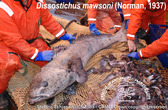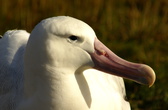-
 10056
10056
-
 10005
10005
Chionodraco hamatus
The characteristic posture of the icefish is “sitting” on the botton kept by its elongate pelvic fins (Montgomery & Macdonald, 1998).
-
 9854
9854
Aptenodytes patagonicus
Common name - King penguin
King penguins are the second largest penguins alive today in terms of size and body weight. The largest penguins are the King penguins’ cousins, the emperor penguins. The International Union for the Conservation of Nature classifies King penguins as “Least Concern”.
-
 9778
9778
Balaenoptera musculus
Common name - Blue Whale
Largest of Earth's animals, the majestic Blue whale can be found in all the world's oceans. In summer, they frequent the fringes of the polar ice shelves, moving to tropical and subtropical waters during the winter months. They travel alone or occasionally in pairs, with the larger individuals occuring the farthest south. Once numbering close to 200,000 individuals, Blue whales were heavily exploited for their oil, meat, and baleen duri...View more
-
 9753
9753Arctocephalus gazella
Common name - Antarctic fur seal (Kerguelen fur seal)
Antarctic fur seals are one of the most numerous mammalian predators in the Antarctic. The population was hunted to near extinction at the start of the 20th Century for its pelt. It has subsequently recovered with the current population estimated to be in the region of 3-4 million. Around breeding beaches small groups or individuals can often be seen porpoising through the water and will often stop to investigate ships or small boats. ...View more
-
 9679
9679Diomedea exulans
Common name - Wandering albatross
The wandering albatross (also referred to as 'Snowy albatross') is an iconic seabird of the Southern Ocean. This large, almost totally white, seabird is unmistakable as it glides effortlessly for hours around ships.
-
 9453
9453
Pyura obesa
Yellow or orange and flask-shaped. This large ascidian grows up to 22cm long.
-
 9397
9397
Pyura setosa
Small and greyish in colour, with its surface completely covered in flexible bristles, making it look more like a sponge than an ascidian. Pyura setosa grows up to 7.5cm long and smaller individuals may have a short stalk.

Search for species, places, guides...
There are no items on your guide yet!
Preview or

